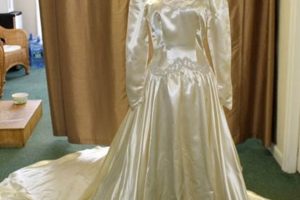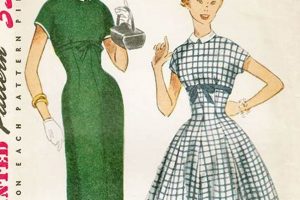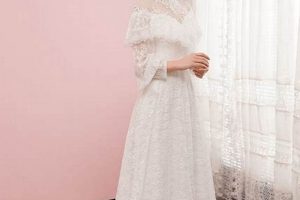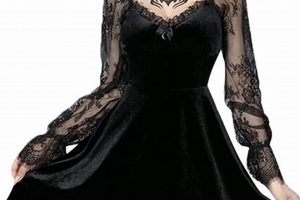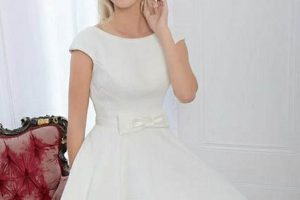A garment characterized by its age and the use of a distinctive, soft, and luxurious fabric, often associated with opulence and historical periods. Such attire embodies design aesthetics and manufacturing techniques prevalent in eras past, offering a tangible connection to previous generations’ fashion sensibilities. For example, a floor-length evening gown from the 1930s, crafted from this plush material, would exemplify this category.
These items hold significance due to their unique textures, historical value, and embodiment of sartorial trends from bygone eras. Their acquisition can provide access to rare and meticulously crafted pieces that often feature details and construction methods no longer common in contemporary apparel production. Furthermore, owning such a piece allows appreciation of historical context within the evolution of clothing and fashion, contributing to a deeper understanding of social and cultural trends.
The following sections will delve into various aspects related to acquiring, caring for, and appreciating garments of this type, including identification of authentic pieces, preservation techniques, and integrating them into a modern wardrobe.
Essential Guidance for the Acquisition and Preservation of Vintage Velvet Attire
The following guidelines are provided to assist in the informed selection and responsible maintenance of antique garments constructed from this particular textile.
Tip 1: Fabric Assessment: Meticulous examination of the fabric is crucial. Inspect for crushing, bald spots, or discoloration, particularly in areas prone to wear, such as elbows and seats. Excessive wear may indicate structural weakness and potential for further damage.
Tip 2: Lining Evaluation: The lining often provides vital structural support. Assess the lining’s integrity. Deterioration or damage to the lining can compromise the garment’s shape and longevity, necessitating professional restoration.
Tip 3: Seam Integrity: Carefully check the seams for stress, fraying, or previous repairs. Weak seams are susceptible to further separation, especially under strain. Reinforcement by a skilled seamstress may be required.
Tip 4: Closure Mechanisms: Evaluate the functionality of zippers, buttons, and hooks. Aged closures are prone to malfunction or breakage. Replacement or repair of these elements may be necessary to ensure proper fit and wearability.
Tip 5: Storage Protocols: Appropriate storage is paramount for preservation. Store on padded hangers, away from direct sunlight and humidity. Consider using garment bags made of breathable materials to protect from dust and pests.
Tip 6: Cleaning Considerations: Avoid machine washing or dry cleaning. Spot clean gently with appropriate solvents. Professional cleaning by a specialist familiar with antique textiles is recommended for comprehensive cleaning.
Tip 7: Purchase Authenticity: Verify provenance from reputable sources. Understand the era of manufacture, which is crucial when valuing vintage velvet clothes and also helps understanding its condition.
Tip 8: Wear With Care: When wearing, avoid harsh or abrasive fabrics to minimize further damage to the sensitive texture.
Adherence to these guidelines will facilitate informed decision-making during acquisition and promote the long-term preservation of these delicate historical textiles.
The subsequent sections will explore styling suggestions and methods for incorporating restored pieces into contemporary ensembles.
1. Fabric Quality
The fabric quality of a vintage velvet dress fundamentally dictates its longevity, appearance, and overall value. The type of velvet used, its fiber content (silk, rayon, or cotton), the density of the pile, and the presence of any embellishments directly influence the garment’s ability to withstand the passage of time. Higher-quality velvet, particularly those constructed from silk or high-grade rayon, demonstrates superior drape, a richer luster, and increased resistance to crushing and wear. Conversely, lower-quality velvets, often made from less durable cotton blends, are more susceptible to damage, exhibiting premature fading, matting, and loss of pile.
The era of manufacture often correlates with fabric quality. For example, pre-World War II garments frequently utilized superior materials and weaving techniques compared to those produced in later decades when synthetic substitutes became more prevalent. Examining the weave structure under magnification can reveal details about its construction; tighter, denser weaves generally indicate a higher-quality fabric. Real-world examples include a 1930s silk velvet evening gown that retains its original sheen and suppleness after decades of proper storage, contrasted with a 1970s rayon velvet dress displaying significant pile crushing and color fading due to the inherent limitations of the fabric.
Understanding fabric quality is critical for both acquisition and preservation. Identifying high-quality vintage velvet allows informed purchasing decisions, minimizing the risk of acquiring a garment with inherent structural weaknesses. Furthermore, this knowledge informs appropriate care strategies, enabling the implementation of cleaning and storage techniques tailored to the specific needs of the textile, thereby maximizing its lifespan. Challenges remain in accurately assessing fiber content without destructive testing, highlighting the importance of consulting textile experts for definitive evaluations and appraisals.
2. Construction Era
The construction era of a velvet garment serves as a significant determinant of its design characteristics, material composition, and overall value. Understanding the period in which a vintage velvet dress was produced provides critical insight into the prevailing fashion trends, manufacturing technologies, and socio-economic factors that influenced its creation.
- Silhouette and Style
The specific silhouette and stylistic details of a dress are direct reflections of the era in which it was constructed. For example, a 1920s velvet dress may feature a dropped waist and beaded embellishments characteristic of the flapper era, while a 1950s velvet dress might exhibit a more defined waist and fuller skirt in line with post-war feminine aesthetics. Identifying these stylistic cues is crucial for accurate dating and authentication.
- Manufacturing Techniques
The techniques employed in the construction of a velvet dress vary significantly across different eras. Hand-sewing, intricate draping, and bespoke tailoring were common in earlier periods, while later decades saw the rise of mass production and the use of machine-made embellishments. Examining the stitching, seam finishes, and presence of factory labels can provide valuable clues about the manufacturing era and its associated techniques.
- Material Sourcing and Composition
The availability and use of specific materials were also era-dependent. Silk velvet was highly prized in the early 20th century, while rayon and synthetic blends became more prevalent as the century progressed. Analysis of the fiber content and the presence of specific dyes or finishes can help to pinpoint the likely construction era. Changes in supply chain influence this.
- Fastening Mechanisms and Hardware
The closures and hardware used on a vintage velvet dress can provide valuable information about its construction era. Hooks and eyes, snaps, early forms of zippers, and button styles evolved over time. For instance, Bakelite buttons were common in the 1930s and 1940s. Specific types of zipper mechanisms are also helpful for narrowing down a garment’s age.
In summary, the construction era of a velvet dress informs much about garment value, longevity, and historical meaning. The details revealed regarding style, materials, and methodology reveal if a dress is well-cared for or an imitation. These facets illuminate the evolution of fabric and construction design throughout the ages.
3. Design Aesthetics
Design aesthetics, encompassing the visual and artistic principles applied to a garment’s creation, significantly influence the appeal and historical significance of a vintage velvet dress. The overall aesthetic reflects the stylistic preferences and artistic movements prevalent during its era of construction, shaping its silhouette, embellishments, and details.
- Silhouette and Form
The shape of a vintage velvet dress reveals prevailing ideals of beauty and femininity. A bias-cut gown from the 1930s exemplifies streamlined elegance, while a full-skirted dress from the 1950s showcases post-war optimism and traditional gender roles. These shapes not only dictated comfort but also embodied the cultural values and artistic trends of each respective period.
- Embellishments and Ornamentation
The decorative elements applied to a velvet dress contribute significantly to its aesthetic character. Hand-beading, intricate embroidery, or the application of lace and trimmings can reflect the craftsmanship and artistic sensibilities of a particular era. A dress from the Art Deco period with geometric patterns and metallic accents stands in stark contrast to a Victorian-era dress adorned with delicate floral embroidery.
- Color Palette and Dyeing Techniques
The color palette and dyeing methods used in a vintage velvet dress can reveal much about the available technologies and aesthetic preferences of its time. Early aniline dyes produced vibrant colors, while natural dyes offered more subdued, earthy tones. Faded or unevenly dyed fabrics can also indicate age and the garment’s exposure to environmental factors. The selection of certain colors also reflects the social norms of the time.
- Texture and Surface Treatment
Beyond the inherent texture of velvet, surface treatments such as pleating, ruching, or the addition of contrasting fabrics further contribute to the garment’s aesthetic appeal. These techniques create visual interest and enhance the tactile qualities of the dress, reflecting the design ingenuity of the era. The utilization of metallic threads or sequins can create a play of light and shadow, adding depth and dimension to the overall design.
Collectively, these design elements define the unique aesthetic identity of a vintage velvet dress, providing a tangible connection to the artistic and cultural currents of its time. An understanding of these principles enhances the appreciation of the artistry involved and informs preservation efforts to maintain the garment’s historical integrity.
4. Preservation State
The preservation state of a vintage velvet dress directly impacts its value, wearability, and historical integrity. The condition reflects the cumulative effects of storage practices, cleaning methods, and usage patterns over its lifespan. Degradation due to improper handling diminishes the garment’s fabric integrity, aesthetic appeal, and historical authenticity. Fading from prolonged exposure to light, crushing of the pile from improper storage, and fiber damage from inappropriate cleaning agents are common forms of deterioration. For instance, a velvet dress stored in direct sunlight for decades will exhibit significant color loss and weakened fibers compared to one carefully stored in a dark, climate-controlled environment. The better preserved a dress is, the more accurately it represents its original design and construction, making preservation a central component in the valuation of such a piece.
Assessing the preservation state requires careful examination of the fabric, lining, seams, and closures. Tears, stains, weakened fibers, and alterations all provide information regarding the level of care, or lack thereof, the garment has received. Prior alterations, while potentially executed to adapt the garment to contemporary styles, may compromise the original design and reduce its collectibility. Identifying and addressing these issues, through professional restoration or careful cleaning, can stabilize the dress and prevent further deterioration. However, extensive restoration may also impact its value by obscuring original details or replacing historical elements with modern components. The goal is to balance preservation with historical integrity, ensuring the garment remains representative of its era.
In conclusion, the preservation state is a critical factor in evaluating a vintage velvet dress. The better the state is the better condition it will be with its lifespan being prolonged. Degradation is a factor when not properly kept. To maintain the value of vintage velvet dress, it should be stored and cleaned properly. Understanding and actively managing the preservation state is essential for both collectors and wearers, ensuring these historically significant garments can be appreciated for generations. However, recognizing the fine line between conservation and irreversible alteration remains an ongoing challenge in this field.
5. Rarity Factor
The “Rarity Factor” significantly influences the valuation and desirability of a vintage velvet dress. Elements contributing to rarity encompass limited production runs, specific design features, historical significance, and exceptional preservation.
- Limited Production Runs
Dresses produced in small quantities, whether due to experimental designs, limited material availability, or the boutique nature of their origin, command higher prices. A dress from a short-lived, avant-garde designer of the 1960s, for instance, benefits from scarcity. The exclusivity conferred by limited availability elevates the dress from mere clothing to a collectible artifact.
- Unique Design Attributes
Certain design elements, such as elaborate embellishments, hand-painted details, or unconventional silhouettes, contribute to a dress’s rarity. A vintage velvet dress adorned with intricate, hand-sewn beadwork, especially if executed with unusual materials or patterns, is inherently more uncommon than a mass-produced design. Features that diverge from prevailing trends increase the garment’s distinctiveness and, consequently, its value.
- Historical Significance
A vintage velvet dress linked to a notable historical event, figure, or cultural movement gains additional value. Dresses worn by celebrities, used in theatrical productions, or representing a significant moment in fashion history command premium prices due to their association with influential moments. For example, a dress worn by a prominent actress in a film noir production offers rarity derived from its cinematic provenance.
- Exceptional Preservation
A vintage velvet dress in pristine condition, showing minimal signs of wear and aging, is inherently rarer than a similar garment with significant damage or alterations. Original components, intact seams, and unfaded colors contribute to the overall rarity of the piece. A dress stored in appropriate conditions, away from light and moisture, retains its original characteristics, making it a more desirable and rare find for collectors.
These factors intertwine to determine the rarity and subsequent desirability of a vintage velvet dress. Recognizing these aspects enables informed appraisal and appreciation of the garment’s unique historical and artistic merit. For example, even if a dress was not from a historical designer, certain aspects such as the textile manufacturing era, the style of the garment, or it’s manufacturing technique will have a value on the over all assessment.
6. Wearability Potential
The wearability potential of a garment has a direct bearing on its utility and value. This is particularly salient in the context of vintage textiles. Garments exhibiting significant wear or damage are often relegated to archival or study purposes, thus diminishing their applicability for practical use. A velvet dress displaying extensive pile loss, seam stress, or irreversible staining may be deemed unsuitable for wear without extensive, and potentially cost-prohibitive, restoration. Conversely, dresses in sound structural condition, with minimal flaws, offer enhanced opportunities for integration into a modern wardrobe.
Several factors contribute to the wearability assessment. Fabric integrity is paramount; velvet, especially antique varieties, is susceptible to crushing, abrasion, and moisture damage. Seam strength is another critical consideration, as weakened seams are prone to failure under stress. The presence of functional closures, such as zippers or buttons, also impacts the ease and security of wear. Finally, the overall style and silhouette of the dress must align with contemporary fashion sensibilities to facilitate integration into modern ensembles. A vintage velvet dress with a timeless silhouette and minimal alterations presents greater wearability potential than a highly stylized garment from a bygone era. As an example, a simple, A-line velvet dress from the 1960s might easily be styled with contemporary accessories, while a heavily embellished Victorian-era gown may require more creative adaptation.
Ultimately, understanding the wearability potential of a vintage velvet dress is essential for prospective buyers and collectors. A realistic evaluation of the garment’s condition and style, relative to its intended use, ensures a satisfying acquisition. The goal is to appreciate and potentially wear the garment, responsibly extending its lifespan while minimizing further deterioration. The practical significance of this understanding enables the preservation of textile history through informed acquisition and conscientious handling. However, some vintage pieces are simply too fragile to wear, highlighting the ongoing ethical challenge of balancing preservation and utilization.
7. Historical Significance
The historical significance of a vintage velvet dress lies in its capacity to represent specific periods, events, and cultural shifts. Such garments offer tangible links to the past, reflecting aesthetic preferences, social norms, and technological advancements of their respective eras. Their role as artifacts necessitates careful consideration of context when evaluating their importance and value.
- Representation of Fashion Eras
A garment’s style, cut, and embellishments often exemplify prevailing fashion trends of a particular era. A 1920s flapper-style dress, for instance, embodies the societal liberation and art deco influences of that decade, distinguishing it from the more structured silhouettes of the 1950s. Understanding these stylistic nuances facilitates the garment’s placement within a specific historical timeline.
- Reflection of Social Norms
The design and material choices of a vintage velvet dress may mirror societal expectations and constraints. For example, a dress from the Victorian era, characterized by high necklines and long sleeves, reflects the period’s emphasis on modesty and social decorum. These features provide insights into the cultural values and social hierarchies of the time.
- Commemoration of Historical Events
Certain vintage velvet dresses may be directly linked to significant historical events. A dress worn at a coronation, a political rally, or a cultural celebration gains additional historical significance due to its association with these events. Documentation and provenance relating to these events enhance the garment’s value as a historical artifact.
- Indicator of Technological Advancements
The construction techniques and materials used in a vintage velvet dress can illustrate technological advancements in textile production and manufacturing. The transition from hand-sewn garments to machine-made clothing, or the introduction of synthetic dyes and fabrics, is evident in the dress’s construction. These details provide insights into the industrial processes and material innovations of the era.
In essence, a vintage velvet dress functions as a historical document, capturing aspects of design, culture, and technology. The dress serves as a relic for each era for understanding societal context. Recognizing and interpreting these elements contributes to a richer understanding of the past, transforming the garment from mere clothing into a valuable historical artifact.
Frequently Asked Questions About Vintage Velvet Dresses
The following section addresses prevalent inquiries regarding the identification, preservation, and value of garments categorized as “vintage velvet dress.”
Question 1: How can authenticity be determined in a garment represented as a “vintage velvet dress?”
Authentication involves assessing several factors, including construction techniques (hand-stitching versus machine-stitching), fabric composition (natural fibers versus synthetics), and style characteristics specific to particular eras. Examination of labels, closures (zippers, buttons), and embellishments provides additional corroborating evidence. Expert consultation from a textile historian or appraiser offers further verification.
Question 2: What are the primary concerns regarding the long-term preservation of a “vintage velvet dress?”
Key preservation concerns include protection from light, humidity, and pests. Proper storage involves using padded hangers or acid-free boxes, wrapping the garment in breathable cotton or muslin, and maintaining a stable environment. Regular inspection for signs of deterioration (fading, crushing, insect damage) is essential. Professional cleaning by a textile conservator is recommended over conventional dry cleaning methods.
Question 3: What cleaning methods are suitable for a “vintage velvet dress?”
Dry cleaning is generally discouraged due to the harsh chemicals involved. Spot cleaning with specialized solvents, applied sparingly and cautiously, may address minor stains. However, comprehensive cleaning should only be performed by a professional textile conservator with expertise in handling delicate vintage fabrics. Attempting to clean a vintage velvet dress without professional guidance can cause irreversible damage.
Question 4: How does the condition of a “vintage velvet dress” affect its monetary value?
Condition is a critical determinant of value. Pristine, unworn dresses command the highest prices, while those exhibiting significant damage (tears, stains, alterations) are worth considerably less. Minor imperfections, such as small repairs or slight fading, may be acceptable, but extensive restoration can also diminish value if it compromises the original fabric or design. Provenance and historical significance can offset condition-related devaluation to some extent.
Question 5: What factors contribute to the rarity and collectibility of a “vintage velvet dress?”
Rarity is influenced by limited production runs, unique design elements, and historical associations. Dresses from renowned designers or those worn by notable figures command premium prices. Exceptional preservation enhances collectibility, as does documentation that verifies the garment’s provenance and historical context. Unusual colors, patterns, or embellishments also contribute to rarity.
Question 6: How should a “vintage velvet dress” be stored to prevent damage and deterioration?
Storage protocols include using padded hangers to maintain the garment’s shape and prevent stress on the fabric. Alternatively, the dress can be carefully folded and stored in an acid-free box lined with muslin or archival tissue paper. Storage areas should be cool, dry, and dark, with minimal exposure to light and humidity. Mothballs or cedar blocks can deter pests, but should not come into direct contact with the fabric.
Proper care, handling, and an understanding of unique attributes are essential when considering vintage velvet dress.
The subsequent sections will delve into current trends and future prospects for these unique textiles.
Conclusion
The preceding analysis has underscored the multifaceted nature of the garment designated “vintage velvet dress.” It has examined the criteria essential for assessing authenticity, condition, and historical importance, providing a framework for understanding these textiles as both articles of clothing and cultural artifacts. From fabric quality and construction techniques to preservation strategies and rarity indicators, each aspect contributes to the value and long-term viability of the item.
Continued appreciation and responsible stewardship are crucial to ensuring the survival of such garments. The knowledge imparted empowers collectors, enthusiasts, and professionals alike to engage with garments in a thoughtful and informed manner. Future efforts should prioritize the refinement of preservation techniques and expanded accessibility to educational resources, thereby securing the legacy of these important pieces of sartorial history for generations to come.


